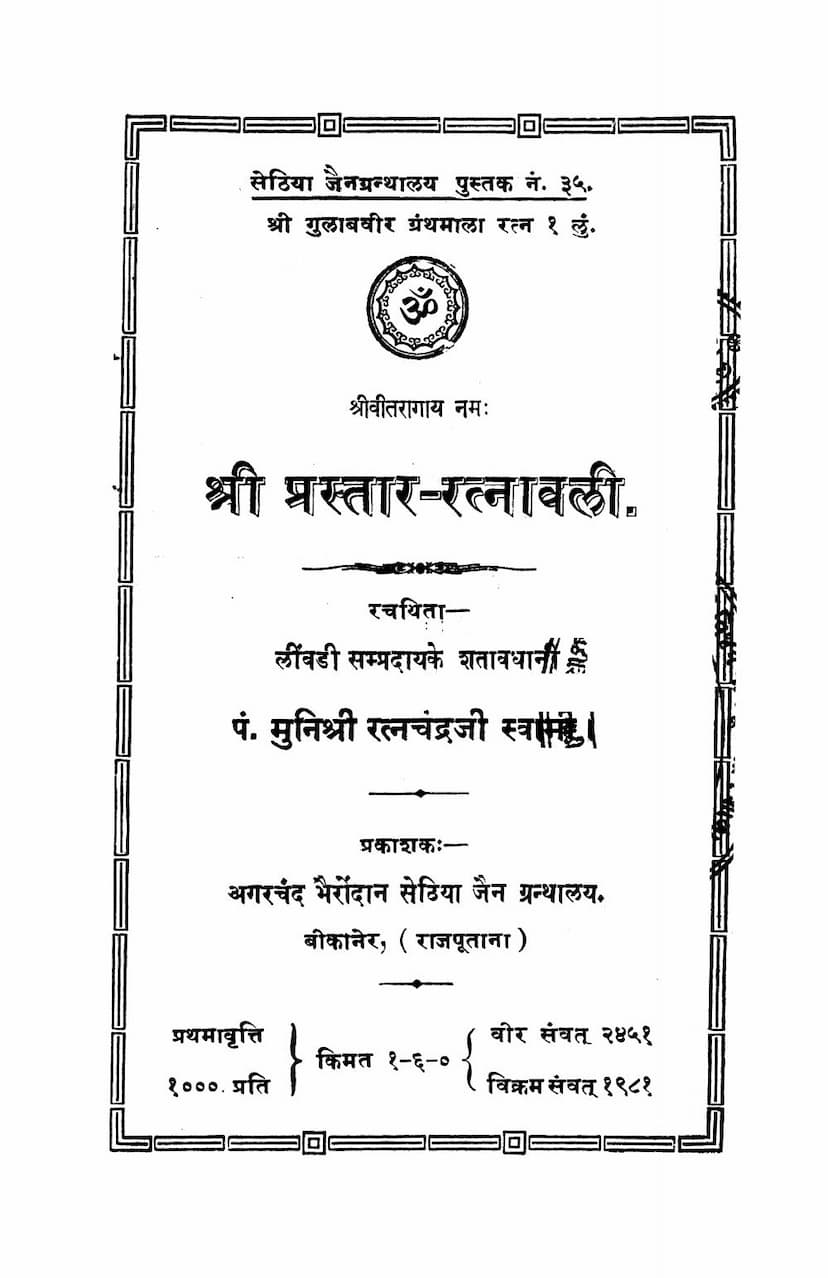Prastar Ratnavali
Added to library: September 2, 2025

Summary
This document is a Jain religious text titled "Prastar Ratnavali" authored by Ratnachandra Swami. Published by Agarchand Bhairodan Sethiya Jain Granthalay in Bikaner, it is the first edition, priced at 1 Rupee and 6 Annas, and was published in Vikram Samvat 1981 (Veer Samvat 2451).
The book is a compilation of several smaller works (totaling 23 chapters) that delve into the complex mathematical and analytical principles within Jain scriptures, particularly focusing on "Bhanga" (combinations or permutations) and "Prastar" (arrangements).
Here's a breakdown of the content based on the provided pages:
Key Components and Chapters:
The book is structured into four main sections or "Granths":
-
Shri Gangey Angar na Bhanga (9 Chapters): This section deals with the "Bhangas" as expounded by the ascetic Gangeya Angar, a disciple of the 23rd Tirthankar Parshvanath, to Lord Mahavir. These are highly intricate discussions on combinations related to life forms and their origins.
- Chapter 1: Pad (Place Arrangements): Explains the principles of arranging or permuting places or locations. It details how to calculate the number of arrangements based on the number of available places and the combinations thereof (e.g., non-conjoint, conjoint pairs, triplets, etc.).
- Chapter 2: Vikalpa (Life Arrangements): Focuses on the arrangements or permutations of life forms. It describes how to calculate the number of permutations of life forms based on different factors.
- Chapter 3: Shuchika (Index/Rule): Explains the methods and formulas to determine the quantity of "Bhangas" and their various combinations.
- Chapter 4: Bhanga (Combinations): Presents the actual "Bhangas" or combinations resulting from the interplay of places and life forms, with examples ranging from one life form and one place up to seven of each.
- Chapter 5: Nashta Vidhi (Lost Method): Details how to determine the specific arrangement or combination without listing all possibilities, useful when a particular arrangement is "lost" or needs to be identified by its number.
- Chapter 6: Uddishta Vidhi (Target Method): Explains how to find the number corresponding to a given arrangement or combination.
- Chapter 7: Meru Vidhi (Meru Method): Introduces a geometrical or graphical method (shaped like Mount Meru) to calculate the number of arrangements and combinations.
- Chapter 8: Pataka Vidhi (Flag Method): Describes another graphical method (shaped like a flag) used to determine the location of combinations within arrangements and to calculate total numbers.
- Chapter 9: Markati (Monkey/Table Method): Presents a tabular method, named "Markati" due to the crisscrossing lines resembling a monkey's movements, used for calculating quantities of non-conjoint, conjoint, and total arrangements.
-
Shravak Vrat Bhang Deepika (6 Chapters): This section focuses on the "Bhangas" related to the vows of lay disciples (Shravaks). It clarifies the breaking or modification of vows and their complex permutations.
- It explains that while the structure for "Pad" (place arrangements) is similar to the Gangeya section, the "Vikalpa" (life arrangements) differ significantly, being derived from the "Shatbhangi" (six-fold permutations) and other systems.
- The "Bhangas" here are based on the combinations of vows, from one to twelve, taken by lay followers.
-
Anupurvi na Bhanga (5 Chapters): This section deals with "Bhangas" related to "Anupurvi," which refers to sequential order or arrangement. It explores permutations where the order is crucial.
- It covers methods for calculating "Bhanga" numbers, the method of writing "Bhanga" arrangements, the "Nashta" (lost) method, the "Uddishta" (target) method, and the method of summing all "Bhanga" numbers.
-
Purvanupurvi na Bhanga (3 Chapters): This section deals with "Bhangas" related to "Purvanupurvi," which are arrangements influenced by previous sequences or causal factors.
- It covers calculating "Bhanga" numbers, the method of writing "Bhanga" arrangements, and the "Meru Vidhi" for finding the initial and final digits of "Bhanga" arrangements.
Overall Purpose and Significance:
The "Prastar Ratnavali" is a highly technical and mathematical treatise within Jain philosophy. Its primary aim is to provide a systematic and comprehensive explanation of "Bhanga" and "Prastar" principles as found in Jain Agamas. These concepts are crucial for understanding the vast enumerations and classifications within Jainism, particularly in areas like cosmology, karma, and the nature of existence.
The author, Ratnachandra Swami, a respected scholar and "Shatavadhani" (someone with extraordinary memory retention), compiled this work to make these complex subjects accessible through detailed explanations, diagrams, and examples. The text emphasizes the intellectual rigor and analytical depth of Jain thought.
The book highlights the practical application of these mathematical concepts for achieving mental concentration and stability during periods of spiritual practice like "Samayika" and "Paushadh." It also draws parallels with similar concepts found in other mathematical traditions like "Pingal Shastra" (for meter) and "Lilavati" (a classic Indian mathematical text).
The publisher, Agarchand Bhairodan Sethiya Jain Granthalay, also used this introductory section to inform the public about their other activities, including free education for children, collection of Jain scriptures, and support for those seeking spiritual renunciation.